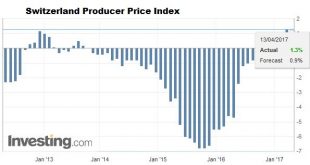In April, the KOF Economic Barometer does not continue its upward tendency, which started at the beginning of 2017, but has declined slightly. However, despite the decline, the indicator is still well above its long-term average. It still indicates a more dynamic economic development than at the beginning of 2017. The recovery of the Swiss economy is likely to continue, albeit with a little less momentum than indicated...
Read More »Swiss Trade Balance March 2017: Increase in Exports and Stagnation of Imports
We do not like Purchasing Power or Real Effective Exchange Rate (REER) as measurement for currencies. For us, the trade balance decides if a currency is overvalued. Only the trade balance can express productivity increases, while REER assumes constant productivity in comparison to trade partners. On the other side, a rising trade surplus may also be caused by a higher savings rate while the trade partners decided to...
Read More »Switzerland UBS Consumption Indicator March: Problem child in retail
The Swiss consumption indicator by UBS shows improvements. The indicator is still distant from the highs in 2012. At the time stronger growth in Emerging Markets and the weaker franc helped the Swiss economy. The UBS consumption indicator registered at 1.50 points in March, indicating private consumption growth around the long-term average. Solid automotive demand drove this figure. Domestic tourism, on the other...
Read More »Swiss Producer and Import Price Index in March 2017: 0.1 percent rise
The Producer Price Index (PPI) or officially named "Producer and Import Price Index" describes the changes in prices for producers and importers. For us it is interesting because it is used in the formula for the Real Effective Exchange Rate. When producers and importers profit on lower price changes when compared to other countries, then the Swiss Franc reduces its overvaluation. The Swiss PPI values of -6% in 2015...
Read More »Switzerland Unemployment in March 2017: Unchanged at 3.3 percent seasonally adjusted
Unemployment Rate (not seasonally adjusted) Registered unemployment in March 2017 – According to the State Secretariat for Economic Affairs (SECO) surveys, 152,280 unemployed persons were registered at the regional employment services centers (RAV) at the end of March 2017, 7,529 less than in the previous month. The unemployment rate thus fell from 3.6% in February 2017 to 3.4% in the reporting month. Switzerland...
Read More »Swiss Consumer Price Index in March 2017: Up +0.6 percent against 2016, +0.2 percent last month
The consumer price index (IPC) increased by 0.2% in March 2017 compared with the previous month, reaching 100.7 points (December 2015=100). Inflation was 0.6% compared with the same month the previous year. These are the results of the Federal Statistical Office (FSO). Switzerland Consumer Price Index (CPI) YoY, March 2017(see more posts on Switzerland Consumer Price Index, ) Source: investing.com - Click to...
Read More »Swiss Retail Sales, February: +0.5 percent Nominal and +0.6 percent Real
The Used Goods Question Retail sales in several countries like Germany, Japan and Switzerland continue to fall or they remain steady for years. In the United States they have strongly risen recently. We should remind readers, that used goods sold via Ebay or similar, are not contained in this statistics. Still they create economic value for the purchases. By mentality, Swiss, Germans or Japanese pay more attention so...
Read More »KOF Economic Barometer: Continues to Rise
In March 2017, the KOF Economic Barometer rose by 0.7 points to a new reading of 107.6. It thus reinforces its previous month’s climb to a level clearly above its long-term average. This indicates that the Swiss economy should grow at above average rates in the near future. In March 2017, the KOF Economic Barometer climbed from 106.9 in February (revised down from 107.2) by 0.7 points to a level of 107.6....
Read More »Switzerland UBS Consumption Indicator February: Domestic tourism rising
The Swiss consumption indicator by UBS shows improvements. The indicator is still distant from the highs in 2012. At the time stronger growth in Emerging Markets and the weaker franc helped the Swiss economy. The UBS consumption indicator rose to 1.50 points in February from 1.44, indicating solid private consumption in the first quarter. Domestic tourism bottomed out and then rose significantly in January. On the...
Read More »Swiss balance of payments and international investment position: Current Account Surplus Up 22%
[unable to retrieve full-text content]Switzerland extended its current account and trade surplus in Q4/2016 by 22%, helped by strong interventions by the Swiss National Bank.
Read More » Swiss Economicblogs.org
Swiss Economicblogs.org









